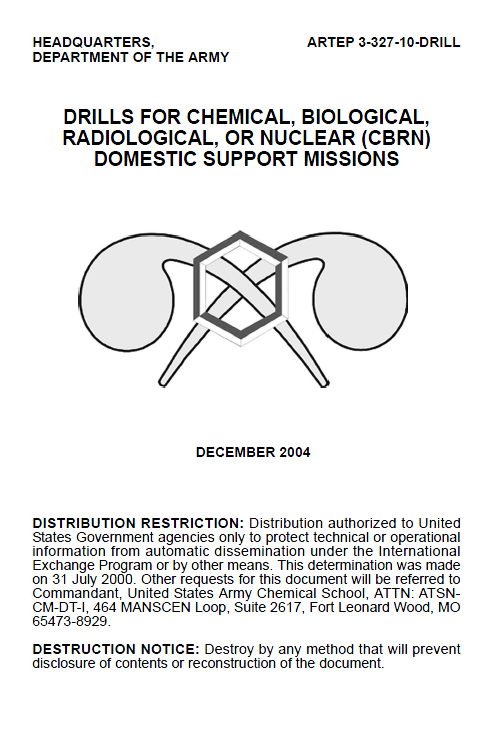ARTEP 3-327-10-DRILL DRILLS FOR CHEMICAL, BIOLOGICAL, RADIOLOGICAL, OR NUCLEAR (CBRN) DOMESTIC SUPPORT MISSIONS
- 97 pages
- Distribution authorized to United States Government agencies only to protect technical or operational information from automatic dissemination under the International Exchange Program or by other means.
- December 2004
This drill book provides platoon, squad, and team leaders with standardized drills that are designed for use by trainers at the platoon and squad level. Standardized drills are essential to the success of platoon leaders, trainers, and small-unit leaders. These drills provide the performance measures, standards, and sequential procedures that will help guide the unit through training tasks for which doctrine is just now being developed. Chemical Corps platoons and squads must be able to perform these drills quickly, effectively, and to standard at all times.
The target audience for this drill book is Chemical Corps squads and platoons who have been assigned the additional chemical, biological, radiological, and nuclear (CBRN) domestic support mission.
…
3-2. Crew Drill 03-3-DC101.
TASK: Prepare for Domestic Response Casualty Decontamination (DRCD) Operations
CONDITIONS (CUE): Terrorist acts involving weapons of mass destruction (WMD) are threatened or have occurred. The unit has received an order to alert, recall, and assemble in support of a DRCD mission. The DRCD equipment has been issued and preloaded into shipping containers. The unit receives the order to prepare for the DRCD operations.
STANDARDS: Each crew member conducts preventive maintenance checks and services (PMCS) on the equipment and vehicles according to the operator’s manual. The equipment and vehicles are prepared according to the unit standard operating procedure (SOP) and load plan. The vehicles are assembled and prepared for convoy movement.
…
TASK STEPS AND PERFORMANCE MEASURES:
NOTE: The medical triage is performed by trained medical personnel and medical support personnel from the local area hospital.
1. The unit establishes medical emergency triage and emergency treatment stations within 30 minutes of receiving the order.
2. Casualties are initially triaged at the medical emergency triage station.
a. Ambulatory casualties are—
(1) Checked for symptoms.
(2) Provided triage tags.
(3) Directed to the log-in station.b. Nonambulatory casualties are—
(1) Checked for symptoms.
(2) Provided triage tags.
(3) Given initial medical treatment.
(4) Placed on litters.
(5) Transported to the log-in station.COACHING POINT:
NOTE: The emergency medical triage and medical treatment stations are located in the hot zone. The emergency medical triage station provides an initial assessment of the casualties. The emergency medical treatment station provides treatment to stabilize the casualties prior to initiating the decontamination process. a. Have the unit leaders explain their parts in the drill.
b. Conduct an after-action review (AAR) to identify strengths, shortcomings, and corrective actions.
c. Reinforce that the medical personnel in the emergency treatment area provide lifesaving emergency medical care only. The amount of medical care given at the emergency medical treatment station will be limited to those actions deemed necessary to stabilize the casualty and increase his survivability throughout the rest of the decontamination process.
…
TASK: Establish a Nonambulatory Clothing Removal Station
CONDITIONS (CUE): Terrorist acts involving weapons of mass destruction (WMD) are threatened or have occurred. The domestic response casualty decontamination (DRCD) unit is given the mission to establish the nonambulatory clothing removal station.
STANDARDS: Establish the nonambulatory clothing removal station in the hot zone. Equip the station with the proper equipment to remove clothing from the casualty, and equip the contaminated-waste receptacles to receive the contaminated clothing.
…
TASK: Establish a Domestic Response Casualty Decontamination Shower System
CONDITIONS (CUE): Terrorist acts involving weapons of mass destruction (WMD) are threatened or have occurred. The platoon is given a complete DRCD shower system. The unit is given the mission to set-up the DRCD shower system.
…
TASK: Establish a Casualty Contamination Check Station
CONDITIONS (CUE): Terrorist acts involving weapons of mass destruction (WMD) are threatened or have occurred. Detection and monitoring equipment are on hand. The unit is given the mission to set up the contamination check station.
STANDARDS: The contamination check station is established in the warm zone. Ambulatory and nonambulatory casualties are checked for residual contamination. Casualties with residual contamination are recycled through the casualty shower unit. Casualties with no signs of residual contamination are forwarded to the redress/cover station.

